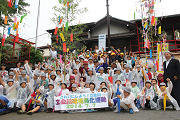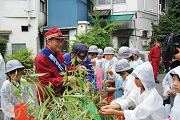Beautification Activities for the Tachiai-gawa River




July 7 is Tanabata as well as the Ministry of Land, Infrastructure, Transport and Tourism’s annual River Day. Shinagawa City is actively working to improve the water quality in rivers and streams flowing through the city and holds annual Tachiai-gawa River Beautification activities around the Tanabata Festival.
Started in 1997, this year marks the event’s nineteenth anniversary. The Tachiai-gawa River Neighborhood Enrich Project, which is consisted of town associations, shopping street associations and local residents work together with local elementary schools, the Shinagawa City government, Tokyo Metropolitan’s Bureau of Sewerage, Bureau of Construction and Bureau of Port and Harbor, the Oi Police Station and the Oi Fire Station on projects to clean and beautify the river.
Carrying banner flags, participants walk two separate routes apart along riverside banks and roads picking up garbage and while promoting beautification to the residents and visitors they encounter along the Tachiai-gawa River and Katsushima Canal.
After the completion of these beautification activities, the local children who participated hold a Tanabata event, where the write out their dearest wishes on small strips of colorful paper that are tied to bamboo branches. These Tanabata decorations, a Japanese custom, are then placed on the“ Bora-chan-bashi Bridge”. A concurrent exhibition of drawings by children at local elementary schools adds to the excitement of the event.
The Milky Way and Tanabata Festival
Japanese have a long history with rivers, having lived alongside them since times of old. Looking up at
the sky, the Japanese saw the Milky Way as a river of stars, and call it “Amanogawa” (lit. “heavenly river”).
A Chinese folktale that is beloved in Japan is the story of the Weaver Girl and the Cowherd. Long, long ago, a princess weaved beautiful cloth along the banks of the Amanogawa. Her father, the Sky King, watched his daughter diligently weave each and every day and decided to match her to a young cowherd who was earnest in his work. They quickly fell in love and married, but were idle and neglected their work. When the Sky King discovered this, he became angry and separated the lovers, placing them on opposite sides of the river. If the two would work hard throughout the year, he said, he would allow them to meet once a year, on the seventh day of the seventh month. Early July is time of the year is when the bright stars Vega (in the constellation Lyra) and Altair (in the Eagle constellation) can be seen late at night on opposite sides of the Milky Way, and these stars are said to be the princess (Vega) and
cowherd (Altair).
July 7 has been designated as“ River Day” because of the river imagery, but also because July 7 is one of Japan’s seasonal festivals, this one for bamboo-leaf. Tanabata is also known as the Star Festival. Although the air in the capital region has improved over the years, the city lights usually prevent viewing the Milky Way, but you can experience the artificial night sky at the Gotanda Cultural Center planetarium (6-5-1 Nishi-gotanda, Tel: 3492-2451) on Saturdays, Sundays and public holidays.







